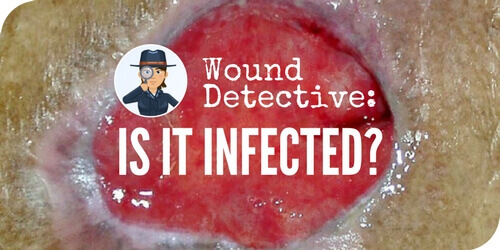How can you tell if a wound is really infected? Learn how to spot the signs of infection and be a skilled wound investigator.
Are you ready, wound detectives, to tackle a new case? This time, we’re learning how to spot the signs of infection. Remember, the wound will tell us what we need to know, we just have to pay careful attention and know what to look for. After all, treatment depends primarily on our clinical assessment (and then a wound culture, if indicated). Sharpen up those investigative skills, and let’s get to work.
The Case
Our patient has a Stage 3 pressure ulcer on the sacrum, measuring 3 x 2.5 x 0.4 cm. Recent documentation includes:
- wound remains the same size for 2 weeks, with 90% granulation tissue and 10% yellow moist slough
- wound edges are defined without epibole
- moderate to heavy serous exudate (drainage)
- no erythema or warmth noted in the periwound area
- no edema, induration, odor, pain, bleeding, or new skin breakdown were noted
So, the question is this: why no healing? Is it infected?
The Mystery
If a wound does not respond to treatment – or presents with signs and symptoms of an increasing bacterial load – we need to look further. We know that all wounds are contaminated with bacteria, but depending on the evidence, they could also be critically colonized or possibly infected.
The Clues
Obviously, the first step to solving the mystery is assessment, and this is where being able to spot those signs of infections comes in. If wounds are critically colonized or infected, treatment plans need to focus on killing bacteria. So, let’s review the definitions.
Critical Colonization – the presence of replicating organisms which cause local tissue damage (look for one or two of the signs and symptoms listed below).
Infection – the invasion of pathologic organisms into surrounding tissue. This occurs when the bacteria have multiplied to the extent that they overwhelm the patient’s immune response and multiple reactions occur (look for three or more of the symptoms listed below).
So, what are the signs and symptoms of bacteria in a wound?
- Increasing or new pain in the wound
- Heat, edema, and/or induration in the periwound area
- Erythema
- Foul odor
- Purulent drainage or increased drainage
- Non-healing wound
- Red and bleeding wound: friable granulation tissue
- Crepitus
Solve the Case
Based on what we now know about indicators, how many symptoms or clues did you count in our case? If you counted two, then you are correct – good sleuthing! Take note that no measurable healing has taken place and that there is increased drainage, which would indicate a critical colonization issue, but not a full infection at this time.
Epilogue
To treat a critically colonized wound, reduce the bacterial load with antiseptics and/or an antimicrobial dressing such as PHMB, silver, medical grade honey or methylene blue. There is no indication to treat with topical, oral, or IV antibiotics until the bacteria overwhelm the host or spread beyond wound margins indicating wound infection.
Are you on the case?
How are your wound detective skills when it comes to recognizing clues, and differentiating between infection and critical colonization? Have you had any particularly challenging cases that were frustrating to solve? We would appreciate hearing about your experiences with identifying infected wounds, so please share your stories and insights below.
Wound Care Education Institute® provides online and onsite courses in the fields of Skin, Wound, Diabetic and Ostomy Management. Health care professionals who meet the eligibility requirements may sit for the prestigious WCC®, DWC® and OMS national board certification examinations through the National Alliance of Wound Care and Ostomy® (NAWCO®). For more information see wcei.net.
What do you think?

